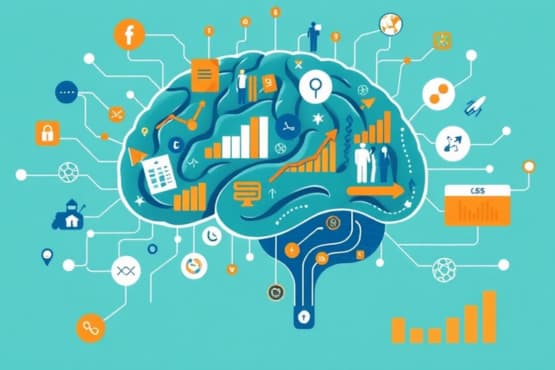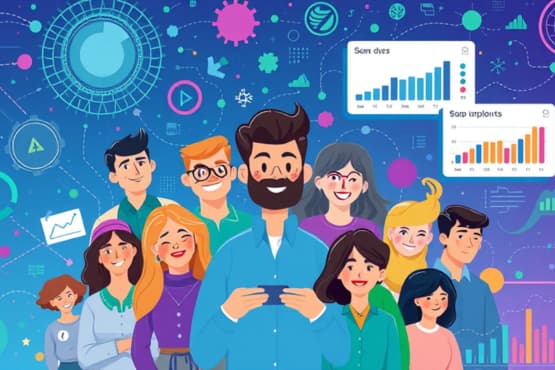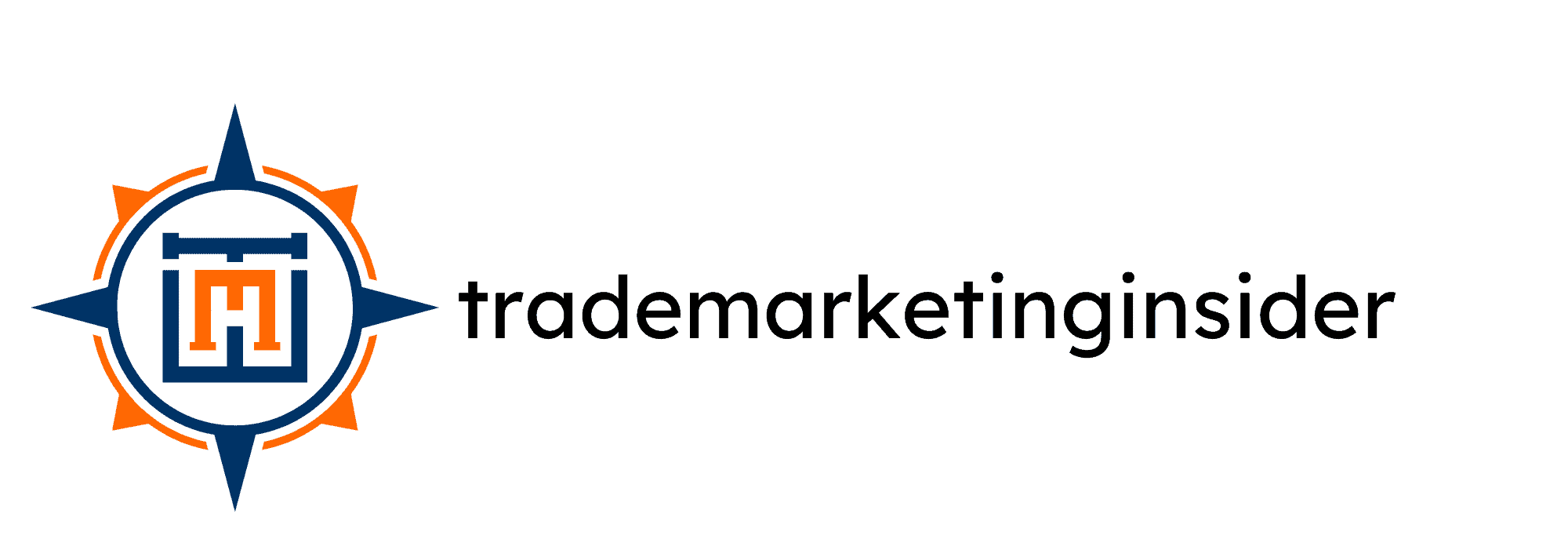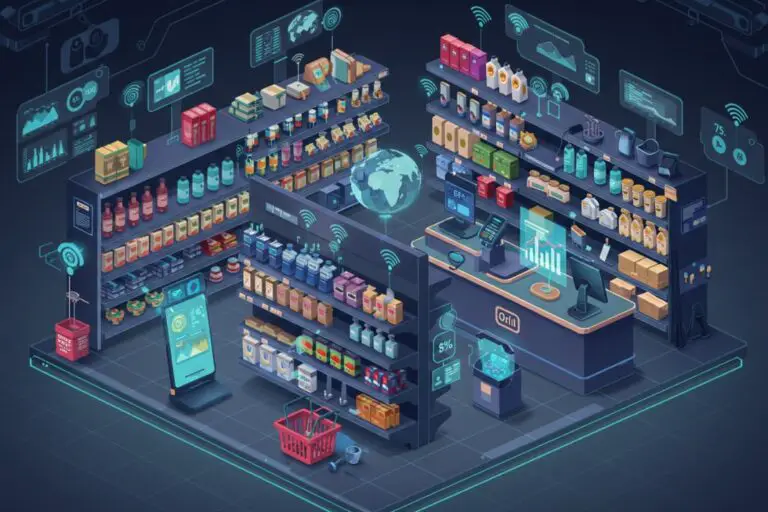Consumer behaviours are changing rapidly, and competition is fierce. To keep up, retailers and trade marketers need smart tools to analyze vast amounts of data and provide real-time actionable insights.
Enter the world of AI and predictive analytics. These powerful tools are transforming how businesses approach trade marketing, offering the ability to anticipate market trends, personalize customer experiences, and optimize operations with remarkable precision.
Why are these technologies becoming indispensable for trade marketers? They can:
- Process massive datasets at speeds impossible for human analysts
- Identify subtle patterns and correlations in consumer behaviour
- Generate predictive insights to drive proactive decision-making
A recent study projects the global AI market to reach $299.64 billion by 2026, growing at a CAGR of 38.1%. This rapid growth underscores AI’s increasing adoption and importance across industries, including trade marketing.
Let’s explore how AI and predictive analytics reshape trade marketing and how businesses can prepare for this data-driven future.
Understanding AI & Predictive Analytics
Definitions and Key Concepts
AI refers to computer systems that can perform tasks typically requiring human intelligence. These systems can learn from experience, adjust to new inputs, and perform human-like tasks.
Predictive analytics uses historical data to forecast future events. It employs various techniques, from data mining, statistics, modeling, and machine learning, to analyze current data and make predictions.
In trade marketing, these technologies work together to:
- Analyze consumer behaviour patterns
- Optimize inventory and supply chain management
- Create personalized marketing campaigns
- Predict market trends and consumer demand

Differences from Traditional Data Analysis
Traditional data analysis often relies on historical data to understand past performance. It’s retrospective and usually requires manual interpretation.
In contrast, AI and predictive analytics are forward-looking. They use historical data to identify patterns and then apply them to current data to predict future outcomes. This approach allows for more proactive and data-driven decision-making.
Synergy Between AI and Predictive Analytics
AI and predictive analytics complement each other in trade marketing:
- AI provides the processing power and learning capabilities to handle vast amounts of data
- Predictive analytics offers statistical models to make sense of this data and generate forecasts
Together, they create a robust system that can:
- Analyze complex consumer behaviour patterns
- Predict future market trends with higher accuracy
- Optimize pricing strategies in real-time
- Deliver hyper-personalized marketing communications
- Improve inventory management and reduce waste
Real-world example: Walmart uses machine learning to optimize its supply chain. By analyzing factors like historical sales data, weather patterns, and local events, Walmart can predict demand for specific products in different stores and adjust its inventory accordingly, reducing overstock by 10-15% in pilot programs.
Current Applications of AI in Trade Marketing
AI for Inventory and Pricing Optimization
One of the most impactful applications of AI in trade marketing is inventory and pricing optimization.

Inventory Management:
- AI analyzes historical sales data, seasonal trends, economic indicators, and even social media sentiment to predict future demand
- This allows businesses to optimize stock levels, reducing both stockouts and overstocking
- Example: Amazon uses machine learning algorithms to predict product demand and optimize its massive inventory, maintaining its promise of fast delivery while minimizing storage costs
Dynamic Pricing:
- AI enables real-time price adjustments based on market conditions, competitor prices, and consumer behaviour
- This maximizes profits while remaining competitive
- Example: Airline companies like Delta and United use AI-powered dynamic pricing to adjust ticket prices based on demand, time of purchase, and other factors, increasing revenue per flight
AI-Driven Customer Engagement
Another crucial application is enhancing customer engagement through personalization:
Personalized Product Recommendations:
- AI analyzes a customer’s browsing history, purchase history, and similar customers’ behaviours to suggest relevant products
- Example: Netflix’s recommendation system analyzes viewing history and preferences to suggest shows and movies, keeping viewers engaged and subscribed

AI-Powered Chatbots and Virtual Assistants:
- These tools handle a large volume of customer queries 24/7, providing instant responses
- This improves customer service while freeing up human agents for complex issues
- Example: H&M uses an AI chatbot on their mobile app to help customers find products, offer style advice, and handle basic customer service queries
Automated Content Creation and Curation:
- AI can generate product descriptions, social media posts, and personalized email content
- This saves time and ensures consistency in marketing communications
- Example: Sephora uses AI to create personalized beauty tips and product recommendations based on individual customer profiles
Predictive Analytics
Types of Predictive Models Used in Trade Marketing
- Regression Models: Predict numerical outcomes (e.g., forecasting sales volumes)
- Classification Models: Categorize data into predefined groups (e.g., predicting which customer segments are likely to respond to a promotion)
- Clustering Models: Group similar data points (e.g., customer segmentation)
- Time Series Models: Analyze time-stamped data to identify trends and seasonality (e.g., forecasting demand over time)
Key Data Sources for Effective Predictive Analytics
- Transactional Data: Historical sales data, purchase histories
- Customer Data: Demographics, preferences, behaviour patterns
- Market Data: Competitor actions, market trends, economic indicators
- Operational Data: Inventory levels, supply chain information
- External Data: Weather patterns, social media trends, local events

Implementing Predictive Analytics in Trade Marketing Strategies
Steps to implement predictive analytics:
- Define clear objectives
- Collect and prepare relevant data
- Choose and train appropriate models
- Integrate insights into decision-making processes
- Continuously monitor and refine the models
ROI Improvement: Predictive analytics can significantly improve marketing ROI when implemented effectively. According to a study by McKinsey, businesses using AI-powered predictive analytics reported:
- 20-30% increase in customer satisfaction rates
- 10-15% reduction in operational costs
- 3-5% increase in sales
AI-Powered Trade Promotion Optimization
Using AI to Maximize Trade Promotion Efficiency
AI helps make promotion investments more efficient by:
- Predicting promotion effectiveness
- Optimizing promotional spend
- Enabling real-time adjustments to promotional strategies

Examples of Successful AI-Powered Promotions
Procter & Gamble Case Study:
- P&G uses AI to optimize trade promotions
- They analyze data from point-of-sale systems and inventory levels
- This helps predict which promotions will be most effective for different products and retailers
- Results:
- 3-5% increase in promotional ROI
- 10% reduction in promotional spending waste
- 2-3% boost in overall sales during promotional periods
Customer Segmentation with AI

Advanced customer profiling techniques:
- AI analyzes vast amounts of data to identify nuanced segments based on behaviour, preferences and predicted future actions
- This goes beyond traditional demographic segmentation
Behavioural prediction models:
- These models forecast how different customer segments are likely to respond to various marketing strategies
Hyper-personalization in trade marketing:
- Tailored marketing messages, product recommendations, and even pricing for individual customers or micro-segments
Example: Spotify’s Discover Weekly playlist
- It uses machine learning to analyze a user’s listening history
- Creates a personalized playlist of new music recommendations each week
- Result: Over 40 million users actively engaging with personalized playlists, leading to increased user retention and subscription growth
AI in Retail Execution
Optimizing Planograms and Product Placement
AI revolutionizes store layouts and product placement by:
- Analyzing sales data, foot traffic patterns, and eye-tracking studies
- Optimizing planograms to maximize sales and improve customer experience
Real-Time Monitoring of In-Store Performance
AI-powered computer vision systems:
- Monitor in-store activity in real-time
- Track customer behaviour and flow
- Monitor stock levels on shelves
- Detect potential security issues

Automated Compliance Checking
AI ensures compliance with promotional agreements and planogram designs:
- Analyzes images from store visits
- Verifies correct product display and promotion execution
- Alert managers to any discrepancies
Example: Walmart’s AI-powered checkout monitoring
- Uses cameras to monitor checkout areas
- Ensures all items in a shopping cart are scanned and paid for
- Results:
- Reduced losses from theft and scanning errors by up to 30%
- Improved checkout accuracy by 15-20%
The Future of AI in Trade Marketing
Emerging Trends and Technologies
- Conversational AI: More sophisticated chatbots and virtual assistants
- Visual AI: Advanced image recognition for analyzing in-store behavior
- Predictive Personalization: AI that anticipates customer needs
- Augmented Reality (AR) Integration: AI-powered AR for virtual try-ons and immersive marketing

Potential Future Applications
- Automated Negotiation Systems: AI that can negotiate deals with suppliers or retailers
- Predictive Maintenance: AI forecasting when store equipment needs maintenance
- Cross-Channel Optimization: Seamless coordination of marketing efforts across all channels
Preparing Your Trade Marketing Strategy for AI Integration
To prepare for this AI-driven future, businesses should:
- Invest in robust data infrastructure
- Cultivate a data-driven culture
- Start with small, focused pilot projects
- Provide continuous AI education for teams
- Stay informed about emerging technologies and regulations
Challenges & Ethical Considerations
Data Privacy and AI Bias

Key issues:
- Data privacy: Increasing consumer awareness of data usage
- AI bias: Risk of perpetuating or amplifying existing biases
Mitigation strategies:
- Implement transparent data usage policies
- Deploy robust data protection measures
- Regularly audit AI systems for bias
- Ensure diverse representation in AI development teams
- Establish clear ethical guidelines for AI use in marketing
Integration with Existing Systems and Processes
Challenges:
- Resistance to change from employees
- Compatibility issues with legacy systems
Solutions:
- Develop a clear change management strategy
- Invest in employee training and upskilling
- Gradually phase in AI technologies
- Choose AI solutions with strong integration capabilities
Skill Gaps and Training Needs
Addressing the skills gap:
- Invest in training programs for existing employees
- Partner with educational institutions to develop relevant curricula
- Consider hiring data scientists and AI specialists
- Foster a culture of continuous learning and adaptation
Measuring the ROI of AI in Trade Marketing
Key Performance Indicators
- Conversion Rate Improvement
- Customer Lifetime Value (CLV) Increase
- Cost Per Acquisition (CPA) Reduction
- Inventory Turnover Rate
- Promotion Effectiveness
- Customer Satisfaction Scores

Attribution Modeling for AI-Influenced Outcomes
- Implement multi-touch attribution models
- Account for AI impact across various customer touchpoints
- Use tools like Google Analytics 4 or Adobe Analytics for advanced attribution
Long-term vs. Short-term Impact Assessment
Balance short-term metrics with long-term strategic impacts:
- Short-term: Improved conversion rates, reduced operational costs
- Long-term: Enhanced customer loyalty, increased market share
Real-world metrics:
- 37% reduction in marketing costs
- 39% increase in revenue
- 25% increase in customer satisfaction rates
- 30% increase in conversion rates
Case Studies
Success Stories of AI Implementation
- Sephora’s Virtual Artist App
- Uses AI and AR for virtual makeup try-on
- Results: 50 million shade try-on in the first year, leading to increased engagement and sales
- IBM and Salesforce Partnership
- Integrated IBM’s Watson AI into Salesforce’s CRM platform
- Enables B2B companies to leverage AI for predictive analytics, personalized recommendations, and automated customer service
- Results: 25% increase in lead quality, 30% reduction in customer service response times
Lessons Learned and Best Practices
- Start with a clear business objective
- Ensure high-quality, diverse data sets
- Involve cross-functional teams in AI implementation
- Continuously monitor and refine AI models
- Prioritize user experience in AI-driven tools
Getting Started with AI in Trade Marketing
Assessing Your Organization’s AI Readiness
AI Readiness Checklist:
- Data availability and quality
- Technical infrastructure
- Team skills and knowledge
- Leadership support
- Organizational culture

Steps to Implement AI in Your Trade Marketing Strategy
- Define clear objectives
- Conduct a comprehensive data audit
- Choose appropriate AI tools or partners
- Start with pilot projects
- Measure results and iterate
- Scale successful initiatives
Choosing the Right AI Tools and Partners
Factors to consider:
- Alignment with specific business needs
- Integration capabilities with existing systems
- Scalability
- Support and training offered
- Data security measures
Recommended tools for trade marketers:
- Salesforce Einstein for CRM and analytics
- IBM Watson for advanced AI capabilities
- Google Cloud AI for machine learning and predictive analytics
- Adobe Sensei for content creation and personalization
Conclusion
Integrating AI and predictive analytics in trade marketing significantly shifts how businesses approach customer engagement, inventory management, and strategic decision-making. These technologies offer unprecedented abilities to anticipate market trends, personalize customer experiences, and optimize operations.
The transformative potential of AI and predictive analytics in trade marketing cannot be overstated. They promise to make marketing efforts more efficient, effective, and responsive to consumer needs. The possibilities are vast and exciting, from hyper-personalized campaigns to real-time inventory optimization.
However, this potential comes with responsibilities. As we embrace these new technologies, we must consider ethical considerations, particularly data privacy and algorithmic bias.
As you continue to explore the transformative potential of predictive analytics and AI in trade marketing, consider visiting TRADE MARKETING INSIDER for valuable insights and resources tailored to your needs.




